new posts in all blogs
Viewing: Blog Posts Tagged with: comic books, Most Recent at Top [Help]
Results 1 - 24 of 24
How to use this Page
You are viewing the most recent posts tagged with the words: comic books in the JacketFlap blog reader. What is a tag? Think of a tag as a keyword or category label. Tags can both help you find posts on JacketFlap.com as well as provide an easy way for you to "remember" and classify posts for later recall. Try adding a tag yourself by clicking "Add a tag" below a post's header. Scroll down through the list of Recent Posts in the left column and click on a post title that sounds interesting. You can view all posts from a specific blog by clicking the Blog name in the right column, or you can click a 'More Posts from this Blog' link in any individual post.

Lisa Harper, a friend of a friend, sent along this photo with the comment:
This picture was taken during a late afternoon/cocktail hour/al fresco impromptu reading session, that became a dinner time storyhour because they couldn’t wait to get to the end of Harry Potter #3. They are: Kory, Finley, and Ella.
Even though my husband hasn’t read my book (he says he’s waiting for the audio version), he reads regularly to our kids, especially our 6-year-old son.
Here are 5 reasons Why Our Son Prefers Dad to Read to Him:
1) Dad does character voices a lot better than Mom
2) Dad has a better recall for the intricacies of plot
3) Dad has a greater affinity for graphic novels.
4) Dad understands that even Lego magazines can be great literature.
5) He’s dad.
Many thanks for all your great work.
—
Lisa is the author of a well-reviewed, award-winning book, A Double LIfe: Discovering Motherhood.

She recently wrote a terrific article over at Literary Mama, titled “Living with Captain Underpants.”
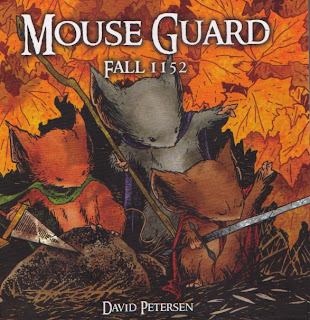


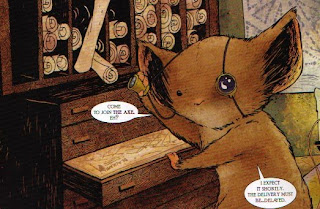
Here's a book you must have. Especially if you like comics or fantasy stories. I heard about this book from James Gurney and immediately picked up a copy. I wasn't dissapointed. The story zooms along at the perfect pace, the art work is that rare and special thing where it works both as a panel telling a story and it also works as an individual image. The colours are great, evoking different moods. And the dipiction of landscape is wonderful. A short explanation of the world is: The Mouse Guard are an elite and old group of specially trained mice that help protect the other mice from predators and other threats. The plot in this story is great, but I don't want to give it away. I highly recommend this book.
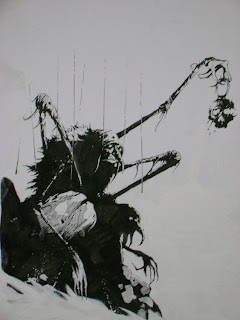 These are Tangle Bones, a type of goblin from the atlantic shore line. They started off in a comic book I had written and they ended up in Bera the trolls world.I like this drawing. I haven't looked at it in years but I like the way the water is crashing against the rocks.
These are Tangle Bones, a type of goblin from the atlantic shore line. They started off in a comic book I had written and they ended up in Bera the trolls world.I like this drawing. I haven't looked at it in years but I like the way the water is crashing against the rocks.
I went to the comic store yesterday. Every few months I'll buy a superhero comic to see if anything good is coming out. I started to get bored of superheros in the mid 90's when Jim Lee dressed the X-Men up in military clothes. All of the sudden comics were too cool to have something as silly as a superhero in tights. I kept collecting but drifted toward other types of comics and later started buying collections of pre 1950's comic strips like Krazy Kat, Terry And The Pirates and Prince Valiant. I did find something really cool yesterday, Marvel Adventures Avengers issue 9. It's a comic book for kids that's not just a retelling of an episode of some saturday morning cartoon. I really loved this issue, it felt like a comic from when I was a kid.
And, happy belated birthday to Erin Gardner. I hope you had a great day!
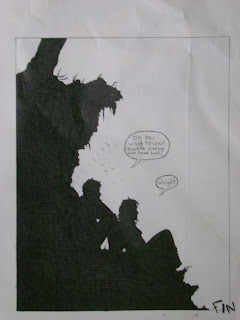

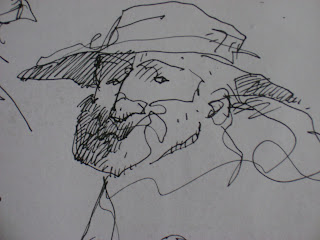
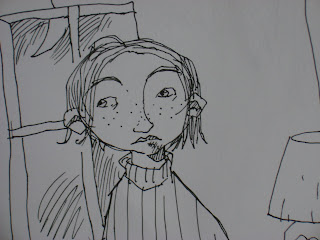
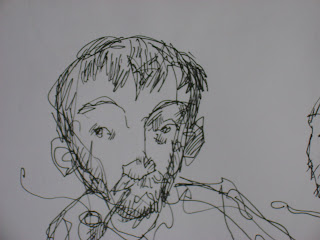
I hope you all enjoyed Harry And Silvio. I finished it up over Christmas and enjoyed doing it a lot. I've scripted the next one and plan to put one out whenever I have the time. At some point I'd like to compile them into a mini comic and sell it on Etsy. I actually started doing mini comics and it's a medium I love revisiting. Now that I have some free time on my hands I've started working on some new stuff : A couple of book proposals, a new send out and some personal work. I've been hard at work on the Twelve Brothers proposal. I have the main character designed and I've sorted out the story board. If anyone has any advice on book proposals I'd love to hear it.
I just read Illustrating Children's Book by Martin Salisbury published by Barrons. It's actually really good. With some great sketches by the fantastic Alexis Deacon. Here are a couple quotes from the book I really liked. The first is on drawing from life and the second is on style, a couple of topics that are pertinent to my blog: " The stronger the drawing (from life ) , the stronger the foundation for experimentation. "
and " Style is a word other people use to describe your work."
The sketches above are from my sketch book. The lamps are down the street from me, every year my neighbor fills up his window with vintage lamps and takes it down at epiphany. My wife took the picture.
P.S. I've added a web comics link list above my archives and I'll be keeping any new comics there.

By: David Elzey,
on 1/9/2008
Blog:
The Excelsior File
(
Login to Add to MyJacketFlap)
JacketFlap tags:
graphic novel,
comic books,
mouly,
toon,
RAW,
spiegelman,
07,
07,
RAW,
spiegelman,
comic books,
mouly,
toon,
Add a tag
Benny and Penny in Just Pretend
by Geoffrey Hayes
Otto's Orange Day
written by Jay Lynch
illustrated by Frank Cammuso
Toon Books/RAW Junior 2007
In a word: Disappointing.
The first releases in a new imprint from he editorial team of Francoise Mouly and Art Spiegelman are probably best described as comic books packaged as graphic novels for the younger set. If they didn't have such a high
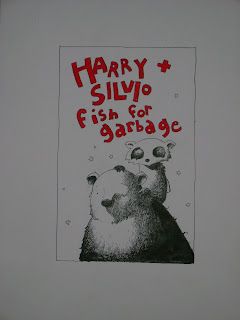
I'm Baaaaaaaaaakkkkkkkkkkkk!!!!!
Hi all it is I Darth Bill back from my yearly meeting on Korriban (where the Sith Academy for Higher Learning is located). It was nice to see some of the old crew like Darth Vader, Darth Bane, Darth Maul and many other fellow Sith along with all the promising young students. Well you could imagine my shock upon my return to find out that that on January 22 from 2 - 4 p.m. the library is having a "Heroes Festival." I immediately spoke up and asked: "What about all of us Villains?????" Needless to say after some debate (threats of bopping the head librarian on the head) they saw my side of the story and it was renamed "The Heroes and Villains Festival". I wonder sometime what this place would do without me (sigh). Below are some pictures from the, um (let me assure you in no way, no how were threats or violence implied to anyone), discussions we had with the head librarian.
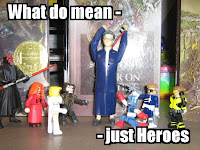
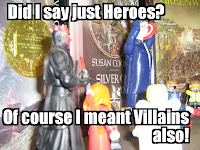 (Head Librarian with hands up -Can't imagine why? Must be some exercise thing?)
(Head Librarian with hands up -Can't imagine why? Must be some exercise thing?)
Comic Book Creators – Stan Lee & Jack KirbyDo you like Comic Books? Do you like Graphic Novels? If you do there are two men you need to know about for whom without their involvement in the
creation of Comics, the landscape as we know it today of Comic Books and Graphic Novels would be much less interesting. The
Comic Book Creators Series has two biographies that have recently come out that focus on two giants of the industry Stan Lee and Jack Kirby.
Stan Lee: Writer & Creator by Sue Hamilton - Stan Lee, if you
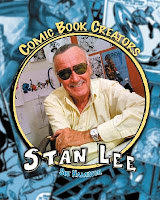
have never heard of him, created such comic characters as Spider-Man (with Steve
Ditko), The X-Men ( with Jack Kirby), The Hulk (with Jack Kirby), The Fantastic Four (with Jack Kirby), Iron Man (with Larry
Lieber), The Avengers (with Jack Kirby), and many, many more superheroes that you probably read stories about and see at the movies now. Stan Lee created Spider-Man with Steve
Ditko way back in 1962. He wrote his first comic in May of 1941 (which happened to be a Captain America Comic).
He has been everything from a writer, editor, publisher, movie maker to “Chairman Emeritus of Marvel Comics” in his long career in the comic’s field. He is a living legend that all whom love comics should love and respect. Read this book to find out even more about this man.
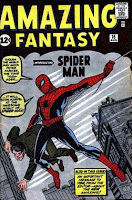
Spider-Man’s first appearance in Amazing Fantasy #15 Aug. 1962 for a mere 15 cents. Today this Comic Book is valued for as much as $32,000. It should be noted that this cover was drawn by Jack Kirby.
Jack Kirby: Creator & Artist by Sue Hamilton - Jack Kirby, also known as Jack “The King”  Kirby, was an illustrator of comics who worked with such men as Stan Lee among many others and created such famous comic characters as Captain America (with Joe Simon), The Fantastic Four (with Stan Lee), The Hulk (with Stan Lee), The X-Men (with Stan Lee), The Mighty Thor (with Larry Lieber and Jack Kirby), The Silver Surfer (with Stan Lee), The New Gods and many, many more that you probably read stories about and see at the movies now also. He worked on his first comic around 1938/1939, but his budding career was interrupted as with many Americans, when World War II broke out and he joined the military. Jack Kirby served under the famous General George S. Patton. When World War II was over he returned to illustrating comics. He worked for both giants of the Comic Book Industry Marvel and DC among other companies and is looked upon, even today, as the King of all Comic Book Illustrators. Read this book and be amazed at this man’s amazing and productive life.
Kirby, was an illustrator of comics who worked with such men as Stan Lee among many others and created such famous comic characters as Captain America (with Joe Simon), The Fantastic Four (with Stan Lee), The Hulk (with Stan Lee), The X-Men (with Stan Lee), The Mighty Thor (with Larry Lieber and Jack Kirby), The Silver Surfer (with Stan Lee), The New Gods and many, many more that you probably read stories about and see at the movies now also. He worked on his first comic around 1938/1939, but his budding career was interrupted as with many Americans, when World War II broke out and he joined the military. Jack Kirby served under the famous General George S. Patton. When World War II was over he returned to illustrating comics. He worked for both giants of the Comic Book Industry Marvel and DC among other companies and is looked upon, even today, as the King of all Comic Book Illustrators. Read this book and be amazed at this man’s amazing and productive life.
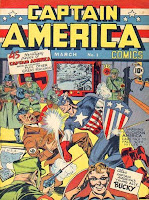
Captain America Comics #1, which was the first appearance of Captain America as created by Joe Simon and Jack Kirby, was first published in 1941 and sold for 10 cents. Today this Comic Book is valued for as much as $80,000.

One last thing I would like to share with you guys is that one of the gentleman, John
DaCosta, who performs the Comics Camps we have once a month at
ImaginOn has illustrated an
Aesop Fables story
The Fox and The Crow. Just click on the title to check it out. I think its pretty sweet!!!
Well guys I don't want to overstay my stay, so peace and take it easy,
Bill
 On a slow train ride from DC last week, I consumed the Identity Crisis graphic novel in a single, greedy sitting. While it wasn't the greatest literary achievment ever, the book reminded me of the joys of serial storytelling--the suspense of what happens in between episodes, issues, or installents of a story released in real time.
On a slow train ride from DC last week, I consumed the Identity Crisis graphic novel in a single, greedy sitting. While it wasn't the greatest literary achievment ever, the book reminded me of the joys of serial storytelling--the suspense of what happens in between episodes, issues, or installents of a story released in real time.
I think all writers should read or watch a serial narrative.
No matter if you are writing blog posts or a novel or daily journalism, your writing could use a healthy dose of an entertaining cliffhanger because-- (click here to continue reading)


Every day we casually flip past sprawling novel-like stories in our newspapers. Just like soap operas or sitcoms, we never stop to ask--Who writes these comic strip scripts that we read over breakfast?
For more than 15 years, Wilson has written the iconic comic strips, Rex Morgan, M.D. and Judge Parker. He took over the job from their creator, Dr. Nicholas Dallis--a psychiatrist turned comic strip pioneer.
Today, Wison gives us a tour of his writing industry in my deceptively simple feature, Five Easy Questions.
In the spirit of Jack Nicholson's mad piano player, I run a weekly set of quality interviews with writing pioneers—delivering some practical, unexpected advice about web writing.
Jason Boog:
What was it like working with Dr. Nicholas Dallis? What are your favorite memories of this comic strip legend? How have these strips changed during your tenure?
Woody Wilson:
Nick Dallis was a prince among men. He was educated, kindly, compassionate, talented and generous.

 What happens when you want to tell a story that no one has ever told before in your medium?
What happens when you want to tell a story that no one has ever told before in your medium?
This fall, comic strip writer Tom Batiuk will kill one of his characters in his comic strip, Funky Winkerbean. That's right, a character in the work-safe, family-safe, and some might say sanitized, world of daily comic strips, is going to die.
The Cleveland Free Times has a fascinating profile of this comic strip storyteller, who has already broken daily cartoon taboos by talking about breast cancer, high school pregnancy, and the Iraq War. His story will give any freelancer hope that someday they can support themselves by writing what they want to write.
As long as you're reading the funny pages, check out our exclusive interview with Woody Wilson, another comic strip writer who writes some of the most famous soap opera-style funnies. After that, spend some time exploring the Daily Cartoonist blog, a tremendous resource for writers of all stripes.
Read this Marshall Ramsey live-blogged cartoon process post for some inspiration. Finally, read The Comics Curmudgeon. The site is often misaligned as a comic-strip-hating, but really, it's the largest funnies-loving community site I've ever seen.

Woody Wilson spent a whole year meticulously crafting abrand new comic strip for syndication--pushing hard to fulfill his dreams of being a comic strip writer. Every syndicate turned him down.
Too many writers give up after their first big project--novel, play, or non-fiction book--is rejected. There's nothing harder than starting over from scratch.
But Wilson didn't quit, and became one of the most influential comic strip writers in the country--helming the iconic comic strip dramas, Rex Morgan, M.D. and Judge Parker.
Today he explains how he survived rejection in my deceptively simple feature, Five Easy Questions. In the spirit of Jack Nicholson's mad piano player, I run a weekly set of quality interviews with writing pioneers—delivering some practical, unexpected advice about web writing.
Jason Boog:
Early in your career, you worked on a strip called "The Little Company." What was it about, can you describe it? What did you learn from that experience? Generally, how does somebody going about pitching a comic strip idea?
Woody Wilson:
The Little Company (1978) was my first strip. It was about a career woman with a not-so-career-oriented husband. Continue reading...

Every day at lunch, I escape the day-job cubicle through my customized comics page at The Houston Chronicle--reading all the gags, drama, and funny pictures crammed into those bitty rectangles.
I dreamed this kind of bounty as a kid--now I can read the comics, interact with other funny page lovers, and track down my favorite comic book writers. The world of comic strip storytelling has changed forever.
To find out how, I tracked down Woody Wilson, the man who has written the comic strip dramas, Rex Morgan, M.D. and Judge Parker, for the last 15 years. He's our special guest this week in my deceptively simple feature, Five Easy Questions.
In the spirit of Jack Nicholson's mad piano player, I run a weekly set of quality interviews with writing pioneers—delivering some practical, unexpected advice about web writing.
Jason Boog:
With the advent of the Internet, a number of fan sites like The Comics Curmudgeon have started analyzing your work. Do you read these web-based fans? How have these websites influenced your work?
Woody Wilson:
Nothing beats interaction with your fans. Continue reading...

Established writers rarely mention the hard times they faced early in their careers. We don't think of William Faulkner as a night watchman or T.S. Eliot as a banker--but both writers had those jobs.The hardest part about writing is believing that you are a novelist/poet/journalist even though you haven't been published yet.
Today we have a very special guest, Woody Wilson--the man who wrote the Rex Morgan M.D. comic strip story you see above.
For more than 15 years, Wilson written the iconic comic strips, Rex Morgan, M.D. and Judge Parker, but he struggled to become a newspaper comic strip writer--just as hard as any starving artist.
Welcome to my deceptively simple feature, Five Easy Questions. In the spirit of Jack Nicholson's mad piano player, I run a weekly set of quality interviews with writing pioneers—delivering some practical, unexpected advice about web publishing.
Jason Boog:
How did you become involved writing comic strip scripts?
Woody Wilson:
In 1978, I met the late Jim Andrews, editor and founder of Universal Press Syndicate. I was living in San Francisco and had been toying with the idea of writing a comic strip.

I have some amazing news. Next week we have an unexpected Five Easy Questions guest named Woody Wilson. Wilson has built a writing career as a journalist and a newspaper comic strip writer. That's right. You are going to meet the man who writes scripts for Rex Morgan, M.D. and Judge Parker. Pow!
Speaking of comics, our buddy Jeff VanderMeer is writing comic book reviews for Bookslut. This week he chops through layers autobiographical excess that we've see in comics and books lately.
For extra credit, read this
New York Times article to see how memoir culture is affecting writers and lawyers alike...
Finally, the stellar Guardian book section celebrates the way the American novel has influenced global prose: "The language of Shakespeare and Milton has evolved into a tougher, smarter beast on the other side of the pond," they write. The essay features a couple beautiful links to other essays about hysterical realism and working class writers. (Thanks to Book Ninja for the link.)
Publishing Spotted collects the best of what's around on writing blogs on any given day. Feel free to send tips and suggestions to your fearless editor: jason [at] thepublishingspot.com.



<
Stop. Immediately.
Hollywood may be awash in all sorts of superheros, spies and pirates but attempting to ride their gravy train in publishing has been a huge mistake. And from the looks of the titles in my review stack there are many editors who just don't get it, especially with the superhero stuff.
I am referring to stories about the boy (always a boy) whose powers are lesser, or
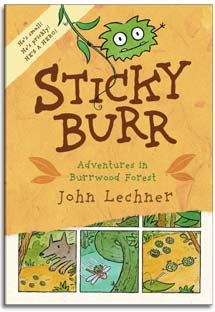
Adventures in Burrwood Forest
by John Lechner
Candlewick 2007
We are not amused.
This comic masquerading as a graphic novel for the emerging reader set has nothing going for it. There's no real character development attempted, no plot to speak of, and in the end has too many similarities with Smurfs for my comfort. Seriously, a land of burrs living in the forest with one token girl burr and an old papa burr. True, there is no Gargamel character, but that wouldn't have made this better.
The oddest thing is that Lechner clearly has skills as an artist, because his backgrounds are wonderful, but the main characters are little more than jagged circles, a tiny doodle any kid could have created. The comic originated online apparently and Lechner's personal connection with illustrator Peter Reynolds may hold the key as to how this landed in Candlewick's lap.
Why is this in hardcover?
Why is this at all?
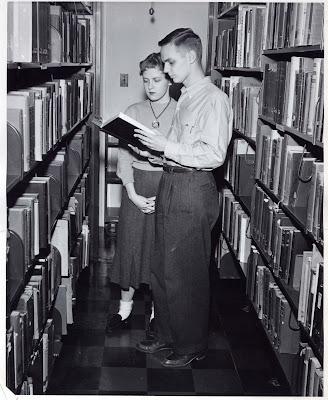 I believe in summer reading. Some of the best memories I have about my summers growing up were the times spent at the local libraries, taking books home on a lazy afternoon and reading until my eyes got blurry or my stomach grumbled. I wasn't a shut-in or a book worm -- I would play pick-up games with kids on the block, or down at the park -- but I did spend a lot of time to myself because I was fairly insecure and introspective.
I believe in summer reading. Some of the best memories I have about my summers growing up were the times spent at the local libraries, taking books home on a lazy afternoon and reading until my eyes got blurry or my stomach grumbled. I wasn't a shut-in or a book worm -- I would play pick-up games with kids on the block, or down at the park -- but I did spend a lot of time to myself because I was fairly insecure and introspective.
Things have changed and now my kids don't just go a couple doors down to play with their friends, they request play dates which need to be coordinated with other parents. The idea of walking down to the local park and hanging out with other kids was predicated on an environment where neighbors looked after one another and the local park had a paid supervisor to check out balls, games, lanyard materials and whatnot. And the summer reading of my youth, always self-directed and rarely encouraged by my mother, has been replaced with a formalized list of titles handed out at the end of the school year for elementary school kids to stress over as they tussle with parents over having their "fun" summer taken away from them.
Along with the myth that homework actually helps children perform better at school, assigned summer reading sounds to me like a clever way to make kids hate books at an earlier age than they might normally. I don't look back at those summers where I would devour books as a punishment, and my girls currently don't seem to have a problem seeking out a new book the minute they finish another, yet when those lists come out and we look over the titles and descriptions of recommended reading there's always a sense of resentment from all parties.
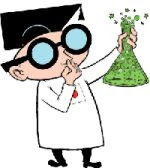 Why are we molding children as young as 8 to accept that summer is a time to "get ahead?" Won't they get enough of this pressure come high school? And why does the material always need to pass some bar of appropriateness, not just for reading level but for content? Is there no room for "play" in summer reading?
Why are we molding children as young as 8 to accept that summer is a time to "get ahead?" Won't they get enough of this pressure come high school? And why does the material always need to pass some bar of appropriateness, not just for reading level but for content? Is there no room for "play" in summer reading?
No. I mean, yes, there is room for play in summer reading. If there isn't, room should be made. To this end I am always in praise of low humor and the types of reading materials often regarded as pop or junk culture and always inconsequential. Since the end of World War II it seems there has always been a voice decrying low humor and popular culture in favor of more refined works. After half a century perhaps we ought to acknowledge that a large portion of the population -- I'm looking at you, Boomers -- have ingested and devoured a fair amount of this inferior printed matter and have been none the worse for it. I see no reason to continue to demonize it any further.
Classic MAD Magazine Paperbacks
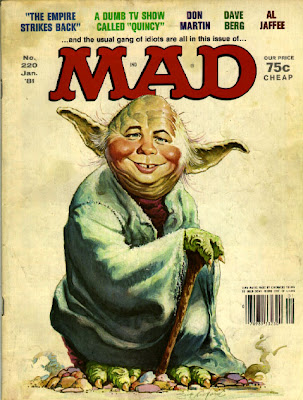 I grew up on Mad magazine. I read plenty of other humor and comic magazines along the way but it always comes back to Mad because it taught me more than most adults would like to admit or give it credit for teaching. Yes, I was a boy, and there's a fair amount of boy-friendly gross-out humor involved, but what else was teaching me social and political satire? How else would I learn about the value (or lack thereof) of popular culture like moves, television and music were it not through their jabbing, critical parodies? Highlighting the inanities of stereotypes and skewering authority skirted the edge of political correctness but in those humorous examinations of human folly I came to understand my own points of view, began to formulate my own opinions and had a good laugh in the process.
I grew up on Mad magazine. I read plenty of other humor and comic magazines along the way but it always comes back to Mad because it taught me more than most adults would like to admit or give it credit for teaching. Yes, I was a boy, and there's a fair amount of boy-friendly gross-out humor involved, but what else was teaching me social and political satire? How else would I learn about the value (or lack thereof) of popular culture like moves, television and music were it not through their jabbing, critical parodies? Highlighting the inanities of stereotypes and skewering authority skirted the edge of political correctness but in those humorous examinations of human folly I came to understand my own points of view, began to formulate my own opinions and had a good laugh in the process.
Currently Mad magazine seems to be suffering. Mad's parent company was acquired over time by Time Warner but the magazine was allowed to run independently until it's founding editor William M. Gaines died in 1992. Since then corporate elements have slowly taken over in an attempt to make the magazine more of a fiscal asset. When the magazine, famous for taking on the absurdities of American advertising, began accepting ads themselves in 2001 most readers, young and old, recognized that Mad was dead. Long live MAD!
My local libraries had spinner racks filled with paperback books and among those were the collections from Mad. Some were artist-centric collections and others were thematic, all of them chock full of material that had appeared in the magazine in the (at that time) 20-plus years of its history. For me there were three artists whose books never failed, whose various approaches to humorous illustration still hold up all these years later: Don Martin, Al Jaffee and Sergio Aragones.
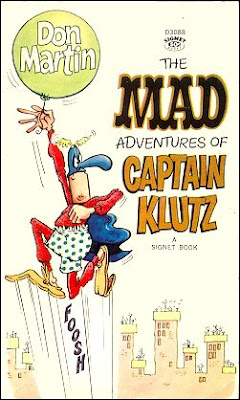 The late Don Martin, nicknamed Mad's Maddest Artist, drew characters with elongated faces and hinged feet and often frozen in some of the most exaggerated "takes" this side of Tex Avery. While Martin's work for the magazine was often single-page comic style stories his books contained longer stories that often poked fun at a number of genres, particularly those based on movies. Al Jaffe, the master of the back cover fold-ins for the magazine, is best known for his "Snappy Answers to Stupid Questions" series, something anyone who works or has worked in retail or customer service can appreciate. It might seem like teaching children how to come up with sarcastic retorts could backfire the larger lesson in these books is to think before asking the unnecessary question in the first place. Finally, Sergio Aragones was the created of the "marginals" the little illustrations tucked in around the corners of the pages of the magazines. In book form his comics dealt in the visual humor of silent movies, a universal humor where the punchline often hinged on the flipping of a stereotype or expectation.
The late Don Martin, nicknamed Mad's Maddest Artist, drew characters with elongated faces and hinged feet and often frozen in some of the most exaggerated "takes" this side of Tex Avery. While Martin's work for the magazine was often single-page comic style stories his books contained longer stories that often poked fun at a number of genres, particularly those based on movies. Al Jaffe, the master of the back cover fold-ins for the magazine, is best known for his "Snappy Answers to Stupid Questions" series, something anyone who works or has worked in retail or customer service can appreciate. It might seem like teaching children how to come up with sarcastic retorts could backfire the larger lesson in these books is to think before asking the unnecessary question in the first place. Finally, Sergio Aragones was the created of the "marginals" the little illustrations tucked in around the corners of the pages of the magazines. In book form his comics dealt in the visual humor of silent movies, a universal humor where the punchline often hinged on the flipping of a stereotype or expectation.
These books were last reprinted back in the 1990's and can be found used usually for under a dollar. For the price of two new paperbacks (one for each of my girls) I can get 8 to 10 of these books, which they will share. Value is a good thing when you're feeding hungry readers.
Comic Strip Collections: Peanuts, Calvin and Hobbes, &c.
Last year we introduced the girls to Calvin and Hobbes but it only really took with my oldest. An excellent comic overall, if a child already hasn't discovered this gem from previous safaris through the library then I highly recommend it. The play between the real and imagined worlds within the comic and Bill Watterson's magnificent draftsmanship make this a winner, and I don't begrudge Watterson for stopping the cartoon at the height of its popularity so he could go out on a high note. It can be a tricky comic to introduce -- my youngest needed to initially have the two worlds explained to her -- but reaps rewards in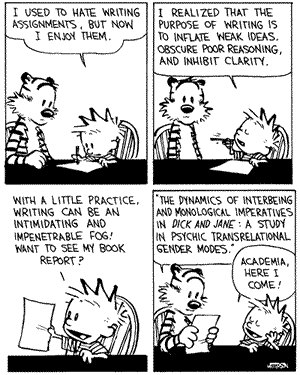 revisiting themes that call on a reader to remember personality and character traits from earlier strips. Actually, this is true of most daily comic strips, but few are as gratifying or as deceptively simple as Calvin and Hobbes.
revisiting themes that call on a reader to remember personality and character traits from earlier strips. Actually, this is true of most daily comic strips, but few are as gratifying or as deceptively simple as Calvin and Hobbes.
Naturally, the grandaddy of them all would be the Peanuts collection, a seemingly endless series of collected dailies currently being captured in annual volumes by Fantagraphics Books, the comic book publisher. There is a certain charm to the Peanuts strips though after all these years I am starting to feel that their genteel quality is showing its age. Charles Schulz kept adults out of his strips (with one or two rare exceptions) and sparingly used pop culture references which has helped to keep them evergreen. For kids who think they have seen it all it's sometimes fun to bust out some "old school" on them and watch them enjoy it.
I remember the summer I found a yard sale and discovered the paperback collections of The Wizard of Id and B.C., the strip collections of Johnny Hart and Brant Parker. I'm not recommending these books directly except to suggest that there's something to be said about "discovering" something not put in front of you. I had a dollar bill burning a whole in my pocket and that was the price of a whole stack of these paperbacks - 17 in total. You feel like you've robbed a bank when you walk away from a sale with an armload of books like that and I'm always on the lookout for another great deal like that. When I finished with those books I hit the library up for the others in the series they had (which I somehow never noticed before) and then started paying more attention to yard sales. And the comics pages of newspapers, which brought me more reading. Some lessons are learned in books and some are learned in consuming them.
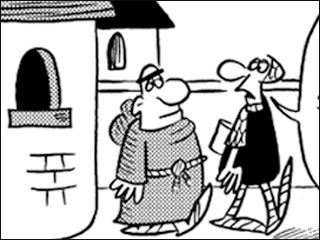 None of this is great literature, though much of it is classic pop culture from the 20th century. Reading comics requires a different set of skills, a combination of reading and observing, drawing pictorial conclusions and making visual analogies. It isn't something we teach children (though we ought to) but it is a language unto itself that teaches the reader as it goes.
None of this is great literature, though much of it is classic pop culture from the 20th century. Reading comics requires a different set of skills, a combination of reading and observing, drawing pictorial conclusions and making visual analogies. It isn't something we teach children (though we ought to) but it is a language unto itself that teaches the reader as it goes.
There are plenty of other possibilities among the ranks of what has generally been relegated to the lower rung of trashy pop culture. It's all part of our neglected cultural heritage.
Comic Books: Mickey Mouse, Archies, Cartoon Network, & The Great Unknown
A recent news item talks about Maryland schools adding comic books to the classroom, and Disney is the company supporting it. This has been one of my fears about the increase in comics and graphic novels, that large corporate entities would make attractive offers to schools and flood them with materials designed to build brand loyalty. Disney has a long history of being in the classroom -- Boomers will remember the filmstrips in science class about VD, Gen Xers would have seen the movie version -- so they aren't strangers to mixing educational content with humor. But when you take something like a comic book and turn it into a teaching tool you take away what's fun about the comic and you ingrain a sense of skepticism that all comics may be as dry as instructional media
No, comics are meant for the summers. They're meant for lazy afternoons in the shade (all summer reading can be an outdoor activity, weather permitting) slurping on a slushie and letting the time slip. I was never a big fan of superheroes -- I never could understand what any kid saw in these fools with their spandex outfits -- but there's plenty of other types of comics in the world. Kid-friendly titles do tend to be hokey but they also present simplified stories of character interaction. Archie Comics aren't going to break any new ground in humor -- they may be the corniest of the bunch -- but they do provide the basic vocabulary in understanding visual media, good for building those future graphic novel skills.
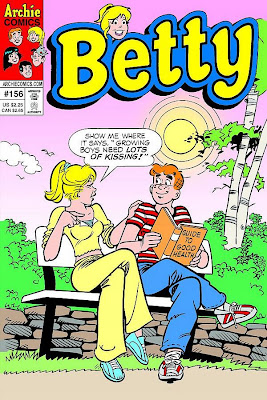 I recently saw a Betty comic (as in Betty and Veronica of the Archie Gang) that told a story of Betty's older sister getting an actual letter in the mail (as opposed to email) and everyone in the house was all jazzed. Turns out it was an apology note that had been lost in the post for years, and as a result Betty's sister had spent years thinking the boy was a lout for standing her up. Curious, she finds his name in the phone book and calls him (something he should have done instead of sending a note) and the upshot is they are rekindling their friendship/romance. Betty is so excited that she goes to her room to email her boyfriend the story and instead he breaks up with through instant messaging. The punchline from the parents is that while modern technology has sped up ability to communicate (and miscommunicate) it hasn't changed the simple truths about relationships, it's just made them happen faster. Very simple, hokey, kid-friendly and an easily digestable chunk of how technology has changed.
I recently saw a Betty comic (as in Betty and Veronica of the Archie Gang) that told a story of Betty's older sister getting an actual letter in the mail (as opposed to email) and everyone in the house was all jazzed. Turns out it was an apology note that had been lost in the post for years, and as a result Betty's sister had spent years thinking the boy was a lout for standing her up. Curious, she finds his name in the phone book and calls him (something he should have done instead of sending a note) and the upshot is they are rekindling their friendship/romance. Betty is so excited that she goes to her room to email her boyfriend the story and instead he breaks up with through instant messaging. The punchline from the parents is that while modern technology has sped up ability to communicate (and miscommunicate) it hasn't changed the simple truths about relationships, it's just made them happen faster. Very simple, hokey, kid-friendly and an easily digestable chunk of how technology has changed.
The Archie and Mickey Mouse comics families are safe but might seem a bit stale to kids already acclimated to what television offers up. For them I'm suggesting most of what the Cartoon Network has in comics form. For superhero girl power, The Powerpuff Girls work well though they recently lost their own comic and are now included in anthology comics featuring a number of stories from different shows. Sure, it does feel a bit like television show promotion, but if it comes down to a choice between watching Camp Lazlo or having them read Camp Lazlo, I'll go for the latter.
Best trick: give a child $10, take them to the comic book store and let them choose whatever $10 will buy. A number of comic book emporiums will have discounted racks or bins with back issues sometimes marked down as much as 50%. Unless the child is comic book collector chances are good it's all new to them and they could come away with quite a haul. Better still: go back to the store alone and buy another bundle and mail it to them in the middle of the summer as a surprise.
Older kids aren't going to be interested in "baby stuff" like Mickey and the Gang and will probably insist on scavenging the Japanese manga titles and standard superhero fare. Older girls may especially feel there is nothing for them in comic books (it is a pretty male dominated field) but let them browse, and ask the store employees for suggestions. There are a lot of alternative and independent comics out there with female protagonists or created by women artists. The art in these comics may look very unfinished or at least unlike most slick comic books out there, but don't let that be the guide. As with any book, the cover can only say so much, it's what's inside that matters.
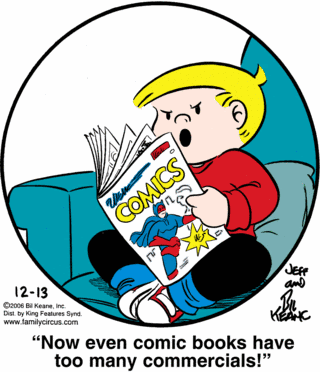 If you are worried about the content that an older comic reader may be attracted to, rather than insisting on approval take a moment to look at the item in question and say "That looks interesting, I'll want to read that when you're finished with it." If there's any doubt about your approval their self-censorship will sink in and make the decision whether or not the material is appropriate. And follow-through, do read the title when they are done and try to understand the appeal without judgment, without questioning. You might learn something about your child you didn't realize, and they might also be telling you something about themselves deliberately.
If you are worried about the content that an older comic reader may be attracted to, rather than insisting on approval take a moment to look at the item in question and say "That looks interesting, I'll want to read that when you're finished with it." If there's any doubt about your approval their self-censorship will sink in and make the decision whether or not the material is appropriate. And follow-through, do read the title when they are done and try to understand the appeal without judgment, without questioning. You might learn something about your child you didn't realize, and they might also be telling you something about themselves deliberately.
Again, I believe in summer reading, but I believe that reading in the summer belongs to the individual reader. They'll get plenty of broccoli during the school year, let them gorge on dessert for a while.
* * * * *
I'm sketching out some ideas...
about the books I think about when I think about summer reading. Despite appearances here, it wasn't always about comics! I'm going to try and present some themes about a week apart, leading up to the end of the traditional school year in mid-June. In the meantime, if anyone else has some personal suggestions for non-traditional (i.e. not found in general fiction) Low Humor that is well-suited for kids (and not already in their radar) please feel free to jump into the comments.
Next Week: Part Two -- Non-fiction?
While I am well on my way to earning an A in one of my best subjects, I want to point you to an article on
the expanded use of comics in reading. While I cringe at the notion of graphic novels and comic books on equal footing, I do applaud the use of varied genres for
ALL readers, not just the reluctant ones. Here is an excerpt.
Maryland's top education official is recommending that Donald Duck and Mickey Mouse start sharing the limelight with classic fiction in classrooms throughout the state.
Superintendent Nancy S. Grasmick, an Archie fan in her youth, tried out comics in third-grade classrooms in eight elementary schools across the state last year. The experiment was so well-received that she will announce today that she wants to expand the use of graphic novels and comic strips to middle schools.
"We never said this program would supplant ... our regular basic reading program," Grasmick said, "but it could provide a huge motivation for some of our students."
On a related note,
Free Comic Book Day was a big hit in my house. William came home with 4 comic books, including Mickey Mouse, 2 Donald Duck, and one Little Archie. We've read them all. What fun!
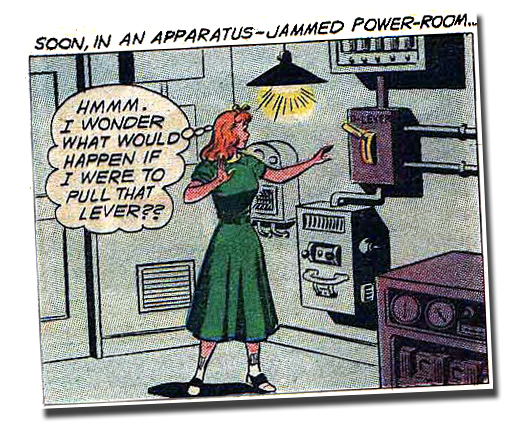
A big thank you to The Excelsior File for reminding me of this one. Unless you've forgotten, tomorrow is Free Comic Book Day. It's the national holiday where you go to your local comic shop guy and demand free stuff. Why is it a holiday? Because on this day they actually give in. You can even go here for a comic book store locator. Those of you with kids should take advantage of this. I grew up on comics and I'm of the firm belief that girls should read more of them.
Thanks too to Lady, That's My Skull (which you should always always go to for your comic blog craziness needs) for the Lana Lang image here.

I know this isn't exactly illustration-related, but Saturday, May 5th is FREE COMIC BOOK DAY!
I can't wait! I'm hoping to score three comic books....
"The Unseen Peanuts" from Fantagraphics Books
"Owly & Korgi" from Top Shelf
"Little Archie" from Archie Comics
Support your local comic book store on Free Comic Book Day!
Buy some comics and score a free comic book (or two)!
It's a great way to get your kid(s) reading!
For more information, visit the offical "Free Comic Book Day" website at: www.freecomicbookday.com
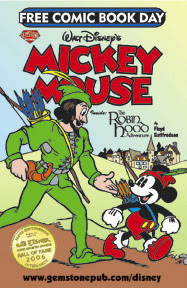
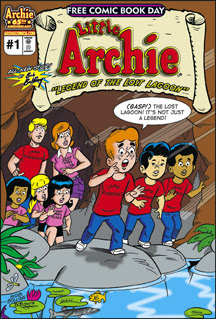 In addition to any Cinco de Mayo festivities you may be planning this coming Saturday might I suggest a trip to your nearest comic book emporium? The first Saturday in May is Free Comic Book Day and it means exactly that: a free comic book from a selection offered by comic book publishers. The site has a handy store locator, descriptions of the comics, comics history and other information.
In addition to any Cinco de Mayo festivities you may be planning this coming Saturday might I suggest a trip to your nearest comic book emporium? The first Saturday in May is Free Comic Book Day and it means exactly that: a free comic book from a selection offered by comic book publishers. The site has a handy store locator, descriptions of the comics, comics history and other information.
The free issues are specifically produced for this event in the hopes of hooking young (an old) readers on comics. It's usually one or two-per person on the free rack, but if you're going with kids and everyone gets something different you can all share in the spoils. My girls loved doing this last year and discovered Owly as a freebie. It wasn't far before we drifted to the racks where the Mickey Mouse comics were and those were a continued hit over the summer. This year there's a free Mickey in the bunch, and an Archie, and a Spidey so it looks like goodies all around.
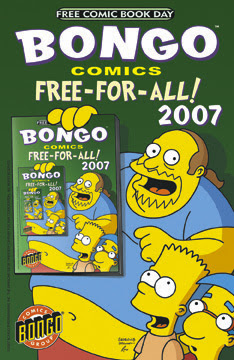
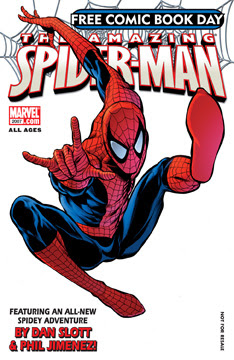 This would be a good time for those interested in graphic novels to visit and see what's out there. There's a pretty big pond out there if you've never taken the dip; most regular book retailers don't even carry a fraction of what's available including a large number of indie comics publishers who can't swing major distribution deals. It might be too busy to chat with the retailers on Saturday about recommendations (though I've yet to meet a comic retailer who didn't love to talk shop) but if not ask what they like for kids and get a whole different perspective on what kids are checking out in a different section of the kidlit marketplace.
This would be a good time for those interested in graphic novels to visit and see what's out there. There's a pretty big pond out there if you've never taken the dip; most regular book retailers don't even carry a fraction of what's available including a large number of indie comics publishers who can't swing major distribution deals. It might be too busy to chat with the retailers on Saturday about recommendations (though I've yet to meet a comic retailer who didn't love to talk shop) but if not ask what they like for kids and get a whole different perspective on what kids are checking out in a different section of the kidlit marketplace.
One more, with feeling: Free stuff.
 What do comic books and fantasy stories have to teach fledgling "regular" or "serious" writers? Everything!
What do comic books and fantasy stories have to teach fledgling "regular" or "serious" writers? Everything!
For every "serious" book I read, I also read a private detective novel, a science fiction story, or a comic book. These genres have influenced my writing just as much as James Joyce or Shakespeare.
I would argue that the writer who doesn't stay in touch with these loose, playful, and enjoyable art forms will never write anything interesting. It's like painting without the bright, happy colors. Do yourself a favor and diversify your reading.
Luckily, lit blogger Edward Champion has a couple links to save us. He created this invaluable round-up of the year's best fantasy writing and linked us to a smart blog exploring the art theory behind comic books. Enjoy...
"Derik Badman continues his ongoing examination of comics, unfurling a close study of the first page of Jaime Hernandez’s “Files on the Ceiling.” Derik, for the love of comics, please get a book deal. This is the kind of analysis that will help people to take comics seriously."












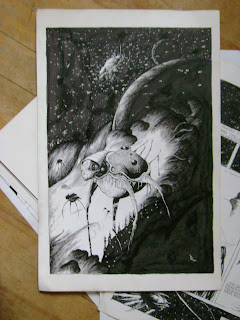
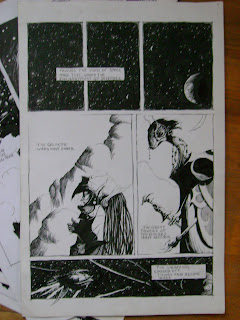
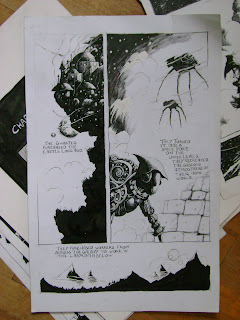
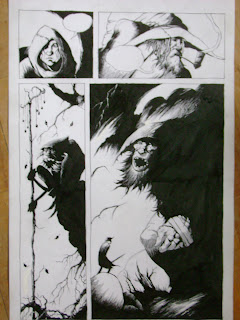
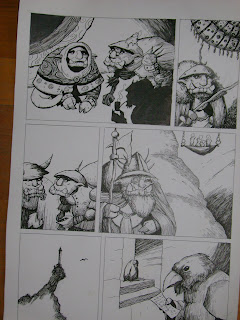
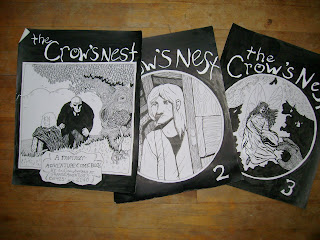






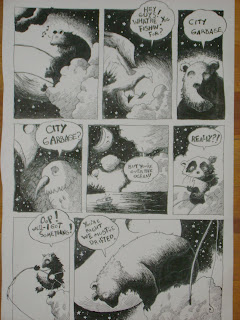
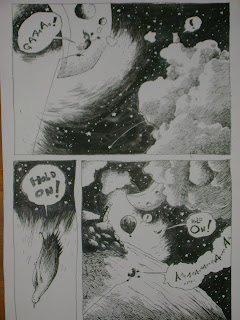
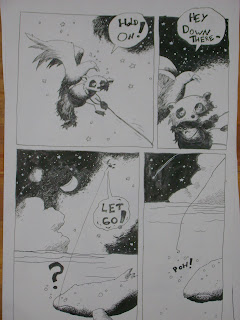
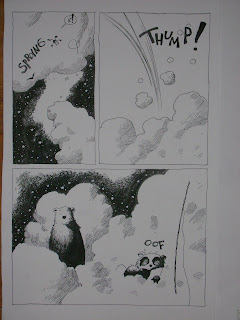





























It's a great book! I can't say enough good things about it.
Wow, nice! Thanks for the review--this is some beautifully illustrated work--love the style.
Great illustrations and the story sounds cool. What age group do you think it is geared toward? Five year olds?
I like that you added this to your blog.
Thanks Frank!
I think I'l do the occasional book review, I read a lot and have few people to share great books with.
It's a bit mature, there's some violence in it and some scary parts. I'd say maybe 11 or 12 and up. I'm not great at giving stories a rating.
Thanks, good to know.
I like the book review idea, or writing about other artists. I have been thinking of writing about some other artists on my blog.
A book review for the five -six year old range would be appreciated.
Hey Eric! Thanks for popping in over at my blog. I have a hard time keeping up other people's blogs, so every time I stop by yours I have ...a "proclivity" of posts to read. It's fun, and your art is great.
I have to say, I was disappointed with Mouse Guard. It was wonderful to look through. Beautifully drawn, but for me it didn't work quite so well as a comic -dialogue and story didn't grab me, and though the pictures were fantastic there was little "acting" with the characters. It would have worked better as a heavily-illustrated short novel.
Ok this is the part where I say...
... Shoot, why do I live so far away from amazing bookstores where I can find all these great works and where the mail system is so awful that things take for ever, that is if they ever arrive?.. and.. well I better stop complaining now.
I'll put in on my long list of great books to buy when I do travel. Thanks Eric.. I love this new "segment" of yours :o)
Thanks Frank, I'll be doing this about twice a month I think.
Hey Ben, glad to know you're still out there.Thanks for the words on Mouse Guard, it's great to have someone elses opinion.
Thanks Alicia! On the plus side you get to live in Venezuala! Slow books but you get to be in a beautiful country.
WOW This mouse is absolutly beautiful!!!!!
Great pictures!!!!!! I like it pretty mutch!!!
Thanks Olgi!
Thanks for this book review. I vaguely remember seeing this cover somewhere, but the inside pics you shared have totally sold me, and I put it on my Amazon wishlist. I read some reviews that said the story is not the best, but honestly, I'll be paying much more attention to the illustrations.
It really is a great book, Angela.